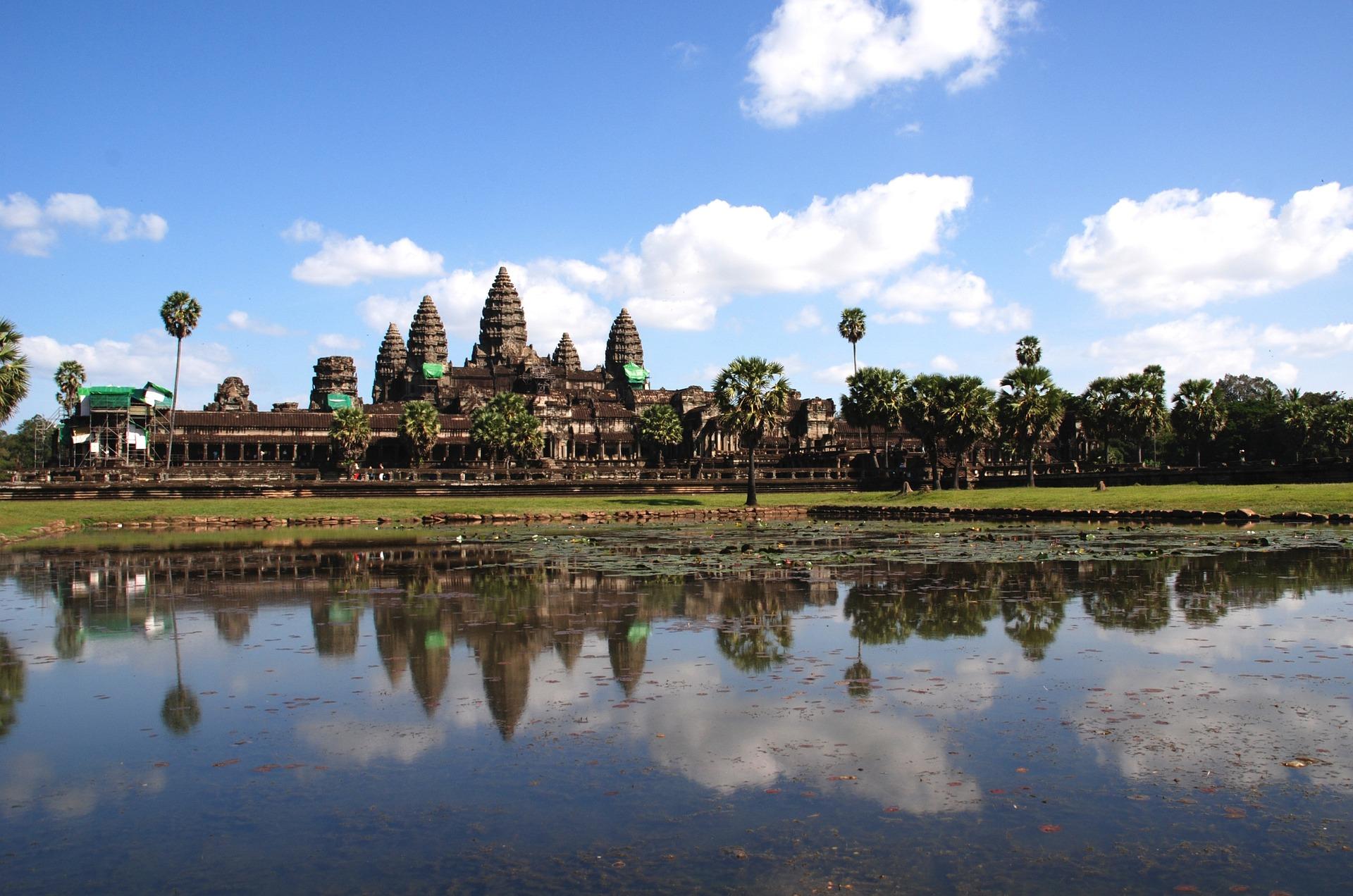Near the Tonlé Sap lake, full of water, fish and fertile soil, lay the capital of the Khmer Empire for five centuries, whose rulers gradually built the largest temple complex in the world with more than 200 buildings – from small towers to majestic temples, dominated by Angkor Wat. To this day, many of them are still covered by the almost impenetrable jungle, which will make you feel like an explorer. Base yourself for a three-day exploration of Angkor in the tourist town of Siem Reap near the international airport. It offers nice accommodation and its restaurants and bars are bustling from early morning to late night. If, on the other hand, you crave tranquillity, there are interesting projects springing up around Angkor, such as The Beige, a luxury resort where you can stay in beautiful tented houses around the rainforest and near mysterious lost temples.
To explore Angkor, it's ideal to hire a bicycle for two days and ride through the mysterious ruins of the Khmer Empire lost in the jungle or among the fields of the eastern plains. You should start exploring the main cities of Angkor Wat and Angkor Thom fairly early in the morning to avoid the unpleasant heat and crowds. The more remote temples can then be visited with the help of a taxi.
Angkor Wat: symbol of the country
As a supreme example of Khmer architecture, the early 12th-century Angkor Wat has become a symbol of Cambodia and takes pride of place on the national flag. The largest and best preserved temple in the region, built as a royal temple during the reign of King Suryavarman II, it was originally dedicated to the god Vishnu. Primarily due to the nearly two hundred metre high moat that protects it from being swallowed up by the surrounding jungle, the temple has never completely fallen into disrepair and remains an important religious centre today.
The main building consists of a huge pyramid with three terraces supporting five massive towers. The tallest tower, the middle one, represents for Hindus the sacred Mount Meru – the centre of the world and the home of the gods, while the other towers symbolise the cardinal points. The building material used is sandstone, which is used for most of the visible surfaces, and brick, which forms the outer walls. The area surrounding the temple used to be the former capital, and the vague perimeter lines of some of the streets are still there, but most of the area is covered by forest.
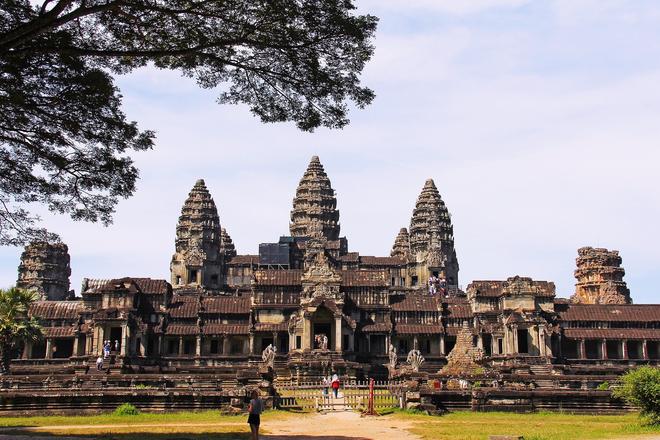
The building is often compared to ancient architecture, especially for its monumentality and perfectly balanced and elaborate details. The sinuous arches, the towers evoking lotus blossoms, the lavishly decorated corridors, the rich wall reliefs depicting deities and elaborate scenes. Not only due to the relentless hand of time, but also as a result of the sacking of Angkor Wat by the Chams, the traditional enemies of the Khmer, many of the ornamental elements have been irreparably damaged. Moreover, some parts of the relief decoration were left unfinished during the construction of the temple.
Angkor Thom and Bayon: Temple of 216 Faces
Bayon Temple is the spiritual and geometric centre of the world and the new city of the empire, Angkor Thom, built by Jayavarman VII, the last great ruler of the Khmer and a supporter of Buddhist philosophy. The city was fortified with a wall and moat, with four gates leading in from four cardinal points – the restored south gate is the finest. Bayon Temple stands exactly in the middle and has more than fifty towers decorated with human faces. These are probably the faces of Avalokiteshvara, the bodhisattva of compassion. An innovation in Angkorian architecture is the central and tallest tower, which is circular in plan. The lower galleries of the Bayon are decorated with a number of realistically depicted bas-reliefs illustrating the life of the ancient Khmer. The most famous is the scene of the Khmer battle with the Chams, while elsewhere the reliefs reveal details of everyday life such as cockfights, feasts and conjurers.
Another road entered the city with a square layout and a side three kilometres long from the east, and connected directly to the longest of the three front staircases of the Terrace of the Elephants, which was part of the royal palace. Another part of the palace is then a wall decorated with hundreds of reliefs, called the "Leper King Terrace".
The ordinary wooden houses that made up the city, along with its many temples and shrines, have of course disappeared without a trace over the centuries, and today you can admire the Khmer monuments in the middle of Angkor Thom, with a backdrop of pretty landscapes of green meadows and shaggy trees with monkeys scampering about. The park's distinctive additions are the stone water tanks that mirror the mysterious sacred towers and pyramids. Most of the city however, is overgrown with jungle, and if you devote only a few hours to exploring, you probably won't realise how extensive it was.
Temples lost in the jungle
Although overshadowed by the glory of Angkor Wat, there are two hundred other important and magnificent temples around the former capital dating back to the 12th century, the heyday of the Khmer Empire. Covering a staggering 230 square kilometres, together they form the largest archaeological site in the world. From the 15th century, when Angkor was conquered by the Thais and the capital moved to a more strategic location on the Mekong River, in present-day Phnom Penh, it lay forgotten and swallowed up by the jungle until its rediscovery in modern times.
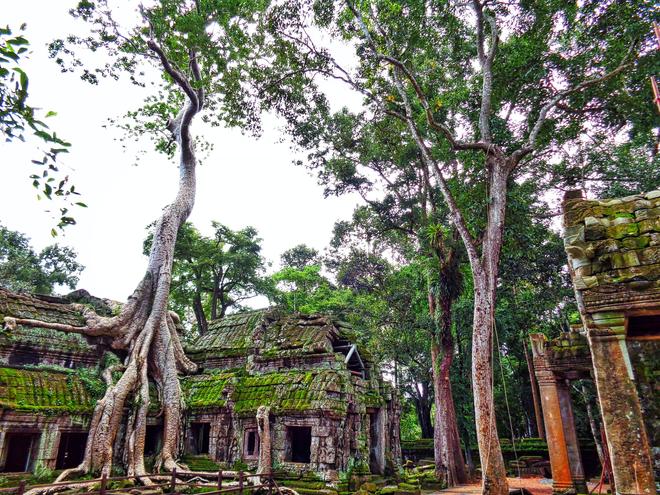
The temples did not serve as places of worship for the faithful; they were fortified palaces of the gods that one did not even have to enter. That's why the sacred towers called Prasat are tall but small in size – enough for a statue of a god and his sacrifices. Most often the temples were dedicated to the Hindu god Shiva, depicted through the symbolic lingam. Later, statues of Buddha were placed in some places and are still used for contemplation and prayer. The great temple was not a palace of one god, but a collection of shrines to up to 430 divine beings, as in the example of the Buddhist temple of Preah Khan.
Preah Khan and Ta Prohm: engulfed by tree roots
The temple, commissioned by the creator of Angkor Thom, can be reached by a short drive through shady forest towards the northeast. The complex is not only a collection of temples and shrines, but also served as a city of Buddhist monks and a university. In no time at all, you will be lost in the mysterious corridors of the holy city. Some corridors lead to shrines, while others end in a collapsed ceiling. There is no one here, and in the dark greenish gloom of a city engulfed in rainforest, you wander with a strange feeling.
A similarly mystical atmosphere pervades the imposing sprawling temple complex of Ta Prohm, which, left in its original state as it was found, is gradually being completely swallowed up by the jungle. Hundreds of years old ruins are permeated by giant tree roots that tightly encircle the stone blocks, as if a giant octopus were ruling over the maze of passages with its tentacles. The overall atmosphere of the lost world is then enhanced by the omnipresent voices of the jungle. Between the two temples, near the overgrown eastern wall of Angkor Thom, you will find other smaller temples hidden in the shade of tall trees – for example, the compact Thommanon, the tiny Ta Nei and the temple mountain Ta Keo.
Neak Pean and East Mebon: playing with water
The huge rectangular dams of West and East Barray held water from the monsoon rains through the dry half of the year, so that the city of half a million with its fields was regularly supplied with water. The water canals also enclosed the walled rectangular cities of Angkor Wat, Angkor Thom and Preah Khan and all the major temples, which, in addition to practical reasons, had the symbolic significance of separating the divine city symbolised by the geometric harmony of Mount Meru from the chaos of the primordial ocean. The architects incorporated the power and harmony of Hindu mythology into the system of canals and reservoirs. On the mandala's ground plan, the island temple of Neak Pean was created, in the middle of the now-dry reservoir supplying the university town of Preah Khan. The circular temple stands in the middle of the main square pool surrounded by four other pools on all sides.
Continue east towards Ta Som Temple, where the road turns south. As you leave the vicinity of the meandering stream, the forest gives way to a deforested landscape and the sun burns relentlessly. Among the rice paddies and farmsteads to the east of Angkor Wat stands the East Mebon Temple. Viewed from an aeroplane, you would notice that the fertile land lies at the bottom of an ancient dam and the three-storey temple was an island in the middle of the huge East Barray reservoir. The temple boasts statues of elephants and the magnificent lining and balustrades of the blinded windows so typical of Angkor.
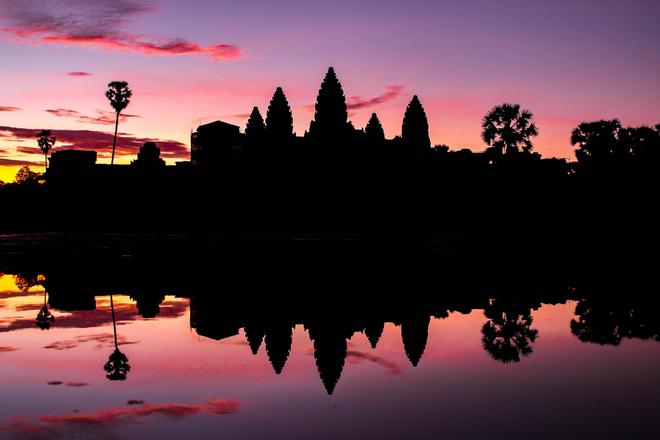
The landscape around East Mebon is very open. Drive southwards and you'll soon pass the red, funny-bearded towers of the brick temple of Pre Rup. The road turns and the glistening surface of the Srah Srang reservoir lies out in front of you like an oasis. The view from the terrace guarded by two stone lions is as refreshing as a late lunch at a local bistro. Dining options are plentiful throughout the complex and it's a good idea to choose the more remote ones, as there are fewer tourists and both friendlier and quicker service. Opposite the reservoir is "his" little town of Banteay Kdei. Nearby Prasat Kravan, also a brick structure, boasts an unusual floor plan of five towers standing in a row side by side and interesting brick bas-reliefs.
Sunset at Phnom Bakheng viewpoint
As the sun is slowly setting, drive west until you reach the back of Angkor Wat. Drive around it on the south side, admire the main west facade again, and end the ride with a steep climb to the viewing hill on which the temple stands. The views of Angkor Wat are spectacular, and the forest of green treetops that for so long obscured one of the world's greatest archaeological discoveries is also interesting to behold. Wait for the evening illumination of Angkor Wat!
Banteay Srei and Bakon: two distant treasures
The best preserved Angkorian temple is Banteay Srei. It may be relatively small, but the finely detailed exquisite relief decoration on the red sandstone has earned it a reputation as the most beautiful temple in Angkor. It lies about 25 kilometres northeast of Angkor at the foot of the Kulen Mountains, the original home of the Khmer Empire and the site from where the sandstone needed for hundreds of temples in the area, was quarried. Although it dates from the 10th century and is thus older than the main temples of Angkor, it has incredibly rich, detailed and well-preserved relief decoration. Alternatively, heading east about 13km from Siem Reap, you'll find another set of temples, of which the five-storey tower of Bakon Temple – the oldest Khmer temple mount – stands out in particular.
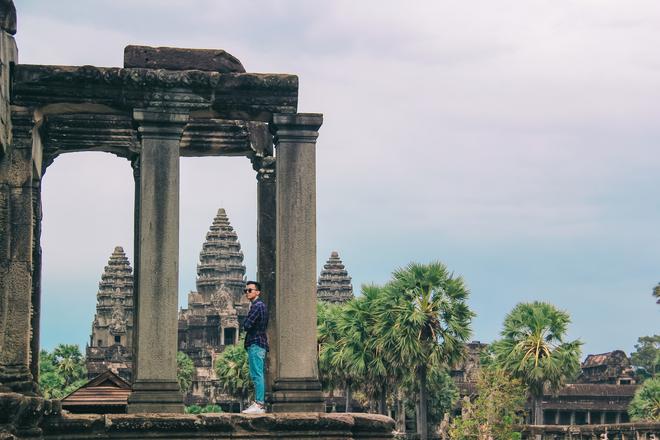
What else you should see
Tonlé Sap Lake – The Mekong's watershed pushes water into the lake, doubling its surface area. Near Siem Reap, you can visit the floating village of Chong Khneas by boat, with houses standing on stilts in the lake.
Phnom Penh – the capital city at the confluence of three rivers. Visit the Royal Palace, the Toul Sleng Museum, a witness to the recent Khmer Rouge genocide, and the Sisowath waterfront promenade, which is packed with locals in the afternoon. There is a relaxed atmosphere as people play sports, chat, families picnic, everyone smiles.
Phnom Bokor National Park – easily accessible from the colonial town of Kampot. You can drive up the road to the top of the mountain, where there are plenty of spectacular views and a Buddhist temple, in addition to some unpleasant remains of a French recreational facility.
The beaches on Koh Rong Samloem – one of the islands with white sand, azure water and a leisurely pace. You'll find several luxurious and tasteful hotels here. Boat transportation is possible from the town of Sihanoukville.
Ratanakiri – a backward mountainous province with beautiful landscapes, waterfalls, fields and villages. An ideal place for trekking and exploring the traditional culture of the Khmer Lou tribe.
